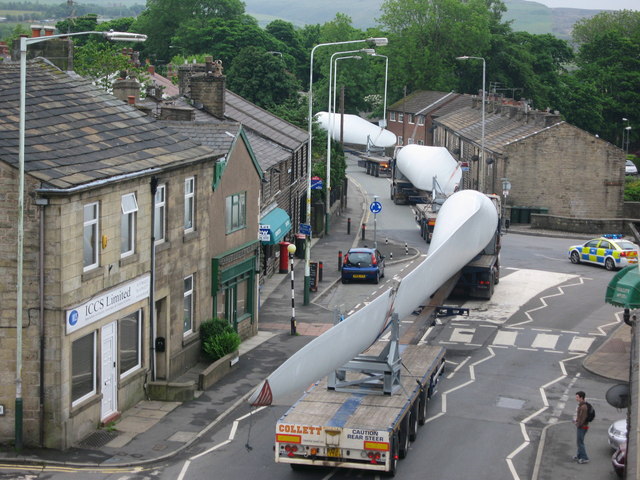From far above the Earth, the London Array looks like rows of perfectly aligned ships sailing toward England’s eastern coast, preparing for a fight. But there’s no need to tilt at these wind turbines, as Don Quixote might. The array is not a monstrous threat — it’s the world’s largest operational offshore wind farm. With 175 turbines covering 100 square kilometers, the array currently provides enough power for about 500,000 United Kingdom homes.
“The London Array has quite an impressive number of turbines. But some of the wind farms on the horizon will be double the size,” says wind energy expert Gregor Giebel of Technical University of Denmark. To ensure the future farms’ success, researchers need a good grasp of how air twists and turns around each turbine, how it flows through the entire farm and even how one wind farm affects another one sitting, well, downwind.

From far above the Earth, the London Array, a wind farm off the coast of England, looks like rows of ships ready to attack. In reality, the turbines provide power for hundreds of thousands of homes in the United Kingdom.
CREDIT: JESSE ALLEN AND ROBERT SIMMON; LANDSAT 8 – OLI/NASA EARTH OBSERVATORY
“Wind energy is coming along very nicely and growing very rapidly,” says Johns Hopkins University engineer Charles Meneveau, who studies the fluid mechanics of wind farms. Right now, land-based wind energy is the least costly form of electricity (if you don’t count subsidies) — less expensive than gas, coal or nuclear power. “People don’t realize this, but it is the cheapest,” Meneveau says. “So that is why one can expect many more wind farms to be built in the next decade.” Offshore wind farms will be a part of that development, too.
Currently, offshore arrays are more expensive to build than land-based ones. But as turbines and arrays grow larger to harvest more energy, Giebel says, moving out to sea may be the best bet to harvest maximum power and avoid issues with construction on land.
Detailed simulations built on supercomputers shows the flow of air in a very large wind farm. The blue regions represent the wakes, low-velocity wind-speed regions, formed behind the turbines. The white streaks represent individual particles, which show how air moves through the array at very different speeds. Such simulations help scientists understand how turbulence acts within turbine arrays and can guide design for more efficient energy generation.
CREDIT: DAVID BOCK/NCSA AND XSEDE; COURTESY OF RICHARD J.A.M. STEVENS
Whether on land or at sea, detailing the intricacies of airflow is essential to extracting maximum electricity from future wind farms. To determine how much power next-gen farms can produce, Meneveau and his colleagues are developing detailed computer simulations of the way air moves through large turbine arrays. In the 2017 Annual Review of Fluid Mechanics, Meneveau and physicist Richard J.A.M. Stevens of the University of Twente in the Netherlands describe the physics of airflow in a wind farm, the way that flow interacts with layers of air above it, and how chaotic changes in airflow actually boost a wind farm’s power output.
By the end of 2016, wind power accounted for an estimated 4 percent of the world's renewable-energy production of electricity.
Unsteady air
Ideally, the most efficient wind farm would situate turbines far apart. But in the real world, real estate for wind farms is limited. So turbines are usually built in denser arrays. The London Array’s 175 turbines, for example, are arranged in a matrix.
Arranging the turbines in a matrix has its problems. The wind loses energy as it moves from one row of turbines to the next. Once past the first row, the oncoming wind forms what’s called a wake, which typically carries only about 50 percent of the wind’s initial strength. Each turbine row the wind encounters will slow the breeze down until, theoretically at least, there should be very little energy from the initial gust left to harvest. Yet wind farm arrays with 20 or even 40 rows of turbines generate energy throughout the array.
Turbulence, Meneveau says, provides the needed boost.
Mere mortals tend not to like turbulence; it’s what jostles you around on a plane at 30,000 feet, leaving you with a slightly queasy feeling. Turbulence, however, is exactly what helps wind turbines extract maximum power from the air. Turbulence is generated when layers of air don’t flow in parallel lines; instead, differences in pressure lead to faster flow velocity, which rough up the air, creating swirls and eddies.
Turbulence in the air above a wind farm stirs energy into the wake behind a turbine, Meneveau and his colleagues’ simulations have shown. Crunching the data from real wind farms plus studying simulations shows that with turbulence, the last rows of turbines can produce just as much power as turbines in the second, third and fourth rows.
Wind farms arranged in rows should, theoretically, lose power as more and more turbines are added: Wakes grow, leaving less wind energy to pass on to turbines in the later rows. However, turbulence from the layer of air above the turbines and from within the wakes can add energy back into the flow, allowing for the turbines in the later rows to generate just as much power as those toward the front.
SOURCE: Adapted from R.J.A.M. Stevens and C. Meneveau/ Annu. Rev. Fluid Mech. 2017
CREDIT: D. BECKNER/KNOWABLE MAGAZINE
But for turbulence to help harvest wind energy, the rows of turbines do have to be placed far enough apart for the wake to have a chance to mix with any rough air. Scientists talk about the distance between rows in terms of rotor diameter, the length of a turbine’s blades. Today’s turbines typically have a rotor diameter of 70 to 120 meters. To maximize the power output and keep the rotors close enough to accommodate space limitations, calculations show, the optimal distance between turbines is about seven times a turbine’s rotor diameter: 500 to 850 meters. But as wind turbines and farms grow larger, Meneveau and a colleague reported in 2012, the optimal distance between turbines could increase to at least 12 times the diameter of a turbine blade — 850 to 1,500 meters. At that distance, the turbines should be far enough apart for turbulence to help the turbines’ wake recover substantially before hitting the next row in the array.
But those calculations don’t provide the final say on the distance between turbines. “You need both the cost of the land and the turbine; only then can you decide where the sweet spot is,” Meneveau says.
For instance, if the land is free and plentiful and there are no electric line costs, then you could put turbines 100 kilometers apart. Each turbine gets fresh wind and is maximally efficient. But if the turbines are free and you pay a lot for the land, then you might put a turbine every three meters. The type of land is also important: the smoother, the better. Forests, ditches, houses and vegetation break down the power of the wind, weakening it before it reaches the first row of turbines. Oklahoma and West Texas are natural locales for building large, well-spaced wind farms. Other types of topographies may call for different approaches to wind energy.
Moving offshore
Offshore wind farms are a good alternative, Giebel argues. The terrain is smooth, with few, if any, obstacles to weaken the wind before it reaches the turbines. There is less turbulence than on land to rebuild the wind strength between turbines, but there is more space to spread the array out.
Also, Giebel says, there are roadblocks, literally, in the logistics of building large-scale onshore wind farms. The turbine blades, towers and other parts are getting so big that trucks run into trouble moving them around corners and under bridges. Offshore construction may be difficult, but there are no size limits. Barges can transport rotors hundreds of meters across and towers 200 to 300 meters tall directly to offshore pads where they’ll be placed.

A single turbine blade can span dozens of meters, making transportation tricky. Trucks must bring them piece by piece to their final destination.
CREDIT: PAUL ANDERSON/WIKIMEDIA COMMONS
The bigger, the better. The seafloor foundations for each turbine are hugely expensive. If the turbines get larger while construction, operations and maintenance costs stay the same, the “cheaper the energy out of the same patch of ocean,” Giebel says.
But researchers don’t yet know if there is a limit to how big they can go with wind turbines and arrays. Questions remain about whether to arrange turbines in a square, an arc or a fan shape to extract the most energy, as well as whether to align the turbines in rows or stagger them. The shape of the wind farm array depends on local conditions at a given site. No general recipes can be stated with confidence, Meneveau says. Specific wind farms must be designed for specific conditions.
Staggering the turbines so they aren’t in perfect rows, however, can increase power production, as suggested by the work of Meneveau, Stevens and others. Meanwhile, Giebel and colleagues have been focusing on the arrangement of turbines and blades, looking to see if there is a way to let just a little bit more energy from the wind slip through each turbine, giving deeper rows slightly more forceful wakes from which to extract energy and maximizing the overall amount generated from each farm.
Along with where to place wind farms, researchers have been studying different turbine arrangements — square, arc and fan, illustrated above. Most large arrays today take the shape of a square. But each location is different. For example, off the coast of Copenhagen is Middelgrunden, a 20-turbine array built in 2000 and arranged on a slight curve to mirror historic fortifications of the city. A recent analysis suggests a more optimal layout might be turbines aligned in a fan or heart shape. Deciding on any specific arrangement depends on local conditions at each site, such as prevailing wind directions, land costs and other factors.
CREDIT: D. BECKNER/KNOWABLE MAGAZINE
Continued research is the only way to anticipate what’s to come, Meneveau says. Wind farm development, he explains, is a lot like the construction of interstate highways decades ago. “In the beginning, no one would have imagined we would have a huge amount of highways crisscrossing the country,” he says. “Whenever we are at a major change in infrastructure, it is sometimes hard to visualize what’s going to happen, so it is crucial that we understand as much as possible about the effects and cross-effects that one might expect from the build-out of wind farms.”
Such arrays have the potential to power all human civilization if built across the oceans, studies suggest. Still, there may be unforeseen environmental effects of large-scale wind farms, such as changes to air moisture and weather. There are also effects on wildlife — both bad (harm to birds and bats) and good (new ecosystems for marine animals like mussels). And any move toward renewable energy creates its own political and economic wake, Meneveau says. Producing wind power on a global scale is probably in for a bumpy ride.




